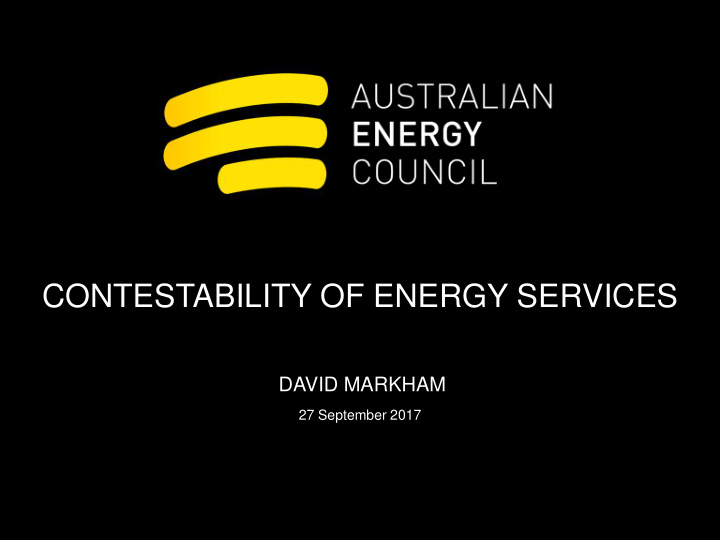



CONTESTABILITY OF ENERGY SERVICES DAVID MARKHAM 27 September 2017
OUR APPROACH The Australian Energy Council is an industry body representing 21 competitive electricity and downstream natural gas businesses. These businesses sell gas and electricity to over 10 million homes and businesses. Competition is the best mechanism for providing services to customers at an efficient cost, to offer them choice of service levels and to drive innovation to continuously improve services. Clarity and stability is essential. If this is not forthcoming, investment decisions may be delayed, and business confidence undermined. Finding ways for stakeholders (other than the regulator and the regulated) to provide a meaningful contribution to exemptions. 27 September 2017 2
A BRIGHT FUTURE Energy storage has enormous and immediate potential. In its 2015 report to the AEMC, CSIRO estimated that energy storage could be viable for households in seven years even under current tariff structures. CSIRO also estimated that energy storage in the NEM could compete against gas within 20 years. The size, the capital requirements and the immediacy of the BTM investment means that we must rely on competitive markets to deliver. Increasing competition with regard to demand response and network support services, and additional services that can be provided by BTM or small scale activity, will lower the overall cost of meeting these requirements. 27 September 2017 3
SAFEGUARDING COMPETITION The draft rule acknowledges that energy storage and generation are able to develop in a competitive environment. The long term interests of consumers are met by the development of competitive markets in services which are or should be contestable. The Commission identified that the ability to restrict competition in a competitive market by restricting access to infrastructure or providing access on less favourable terms than to its affiliate needs to be addressed. No barriers to the NSP’s ring fenced affiliate participating equally in the competitive BTM market. And no barrier to NSP’s procuring distribution services from competitive BTM assets. 27 September 2017 4
OPTIMISING VALUE The Commission agreed that if NSP’s are in control of BTM assets, they may favour network benefits at the expense of maximising the value across the electricity system as a whole. As increasing intermittent generation hits the market, the need to accommodate and allocate the values of the network peak, and the energy peak, mean that the NSP is not the best party to make the investment decision. Dynamic price signals covering all parts of the value chain need to be seen so as markets can respond accordingly. The NSP will still be able to deliver its direct control services at the most efficient cost. It will also allow for co-optimisation of network support services and customer value. 27 September 2017 5
DISCRIMINATION AND CROSS SUBSIDY Regulators have struggled with the reverse burden of accommodating the regulated rather than instead facilitating true competition to promote efficiency and economic growth. Ring fencing is not about restricting the legitimate competitive activities of a related entity. Not everybody should be a natural monopoly, but anybody can be a commercial business. Ring-fencing, cost allocation and the innovation incentive schemes, and their interaction with the draft decision, remain issues that require further review. Flexibility (6.4.B.1), especially in the form of too broadly interpretable views, should be seen as an inferior regulatory principle to consistency, and also to predictability. 27 September 2017 6
Recommend
More recommend